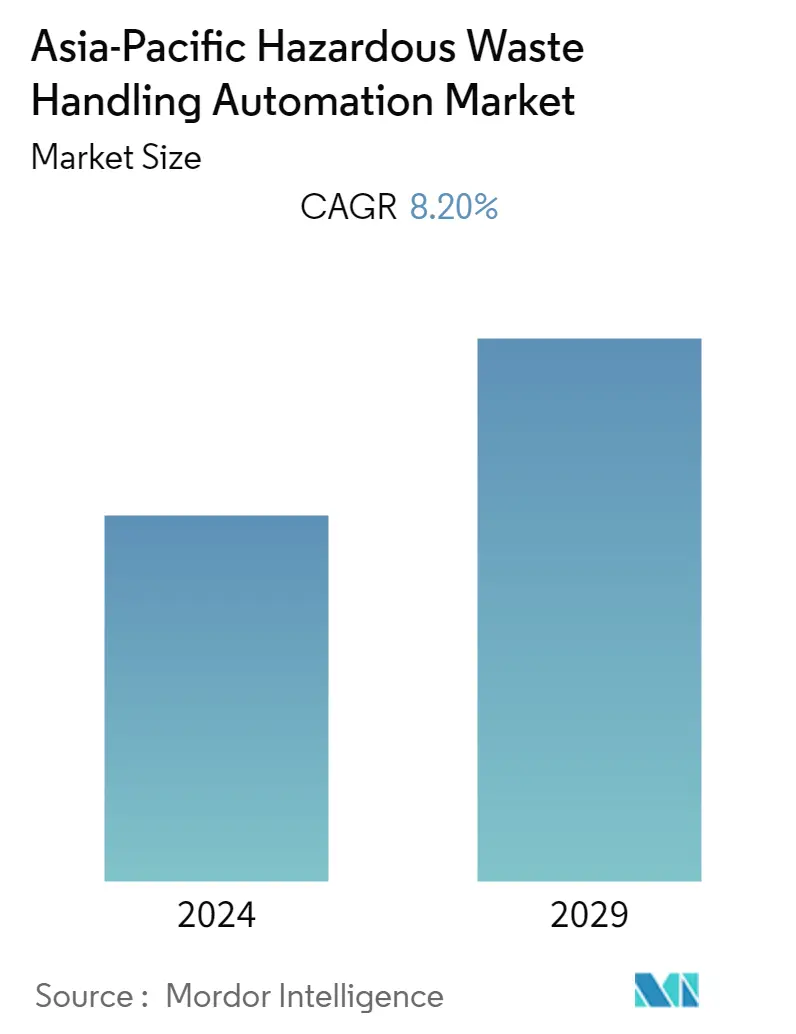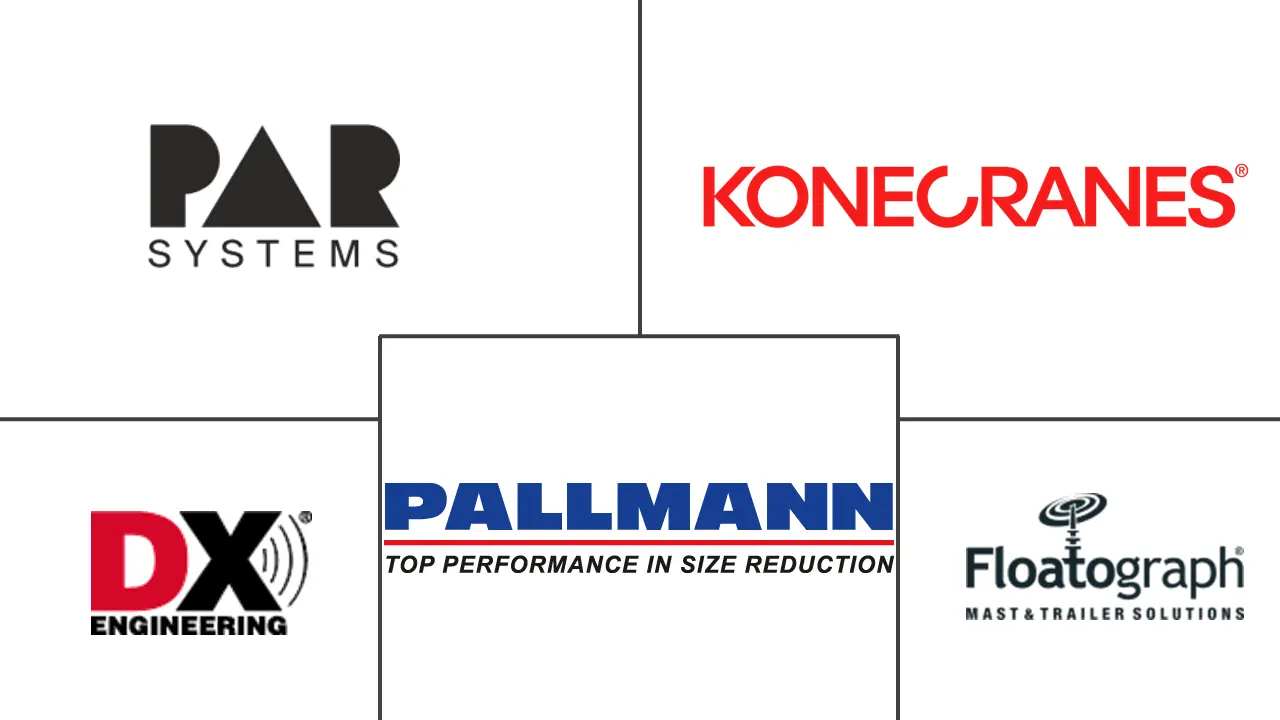Market Size of Asia-Pacific Hazardous Waste Handling Automation Industry

| Study Period | 2019 - 2029 |
| Base Year For Estimation | 2023 |
| Forecast Data Period | 2024 - 2029 |
| Historical Data Period | 2019 - 2022 |
| CAGR | 8.20 % |
| Market Concentration | Medium |
Major Players
*Disclaimer: Major Players sorted in no particular order |
APAC Hazardous Waste Handling Automation Market Analysis
The Asia-Pacific hazardous waste handling automation market is expected to register a CAGR of 8.2% during the forecast period. With the outbreak of COVID-19, companies are offering innovative solutions to foster automation solutions in the waste management industry. Waste products from the manufacturing industries, such as paints, oils, batteries, strong acids and bases, reactive substances, and other ignitable wastes, should be disposed of with special care. The improper disposal of these wastes impacts the environment to a great extent. Therefore, the increasing amount of waste from the production and manufacturing sector is driving the market's growth.
- The hazardous waste handling automation market is expected to grow significantly over the forecast period due to stringent governmental and industrial regulations to maintain people's safety from hazardous waste and the harm caused to the people and the environment.
- Furthermore, several non-government organizations (NGOs) and community-based organizations (CBOs) are stepping in to help hospitals and other healthcare facilities collect, recycle, and dispose of medical waste. Such initiatives are expected to boost the adoption of automation solutions for waste management.
- Hazardous waste consists of the materials generated daily by people, power plants, and manufacturing companies. Using such automation solutions for handling waste improves the process efficiency and reduces manual intervention reliability, as it can be dangerous to the human body. Hence, the concerns about properly handling these harmful substances can be eliminated. Such increasing safety concerns are expected to boost the demand for automation solutions in waste management in the region.
- Also, hazardous waste poses an enormous threat to public health. It must be treated, recycled, and disposed of effectively to prevent environmental pollution. The growing awareness has brought the government's attention toward setting up rules that can help effectively tackle these wastes.
APAC Hazardous Waste Handling Automation Industry Segmentation
Hazardous waste management is the collection, disposal, and treatment of harmful materials. If improperly handled, it can cause substantial harm to human health and the environment. Some of these wastes can be handled manually, while some may require expertise and automation solutions to minimize human contact with the waste.
The study analyzes the adoption of various products, such as manipulator arms, telescoping masts, cranes, trusses, and size reduction systems, for handling several types of wastes, like listed wastes, characteristic wastes, universal wastes, and mixed wastes.
The study also analyzes the applications of these products across various end-user industries, such as manufacturing, chemical, energy, consumer care, and government. The study comprises a brief analysis of the impact of COVID-19 on the market.
| Type of Waste | |
| Listed Wastes | |
| Characteristic Wastes | |
| Universal Wastes | |
| Mixed Wastes |
| Product | |
| Manipulator Arms | |
| Telescoping Masts | |
| Cranes | |
| Trusses | |
| Size Reduction Systems | |
| Other Products |
| End-user Industry | |
| Manufacturing | |
| Chemical | |
| Energy | |
| Consumer Care | |
| Government | |
| Other End-user Industries |
| Country | |
| China | |
| Japan | |
| India | |
| Rest of Asia Pacific |
Asia-Pacific Hazardous Waste Handling Automation Market Size Summary
The Asia-Pacific hazardous waste handling automation market is poised for significant growth, driven by the increasing need for efficient waste management solutions in response to stringent environmental regulations and safety concerns. The market is experiencing a surge in demand due to the rising volume of hazardous waste generated by manufacturing industries, including paints, oils, batteries, and reactive substances. The improper disposal of these materials poses a substantial threat to public health and the environment, prompting governments and organizations to implement stricter regulations and promote automation solutions. The COVID-19 pandemic has further accelerated the adoption of innovative automation technologies in waste management, as companies seek to enhance process efficiency and reduce manual intervention in handling hazardous materials.
The market landscape is characterized by moderate competition, with key players focusing on product launches, research and development, and strategic partnerships to maintain their competitive edge. The expansion of metropolitan areas and the need for improved waste collection and transportation efficiency are also contributing to market growth. Initiatives by organizations such as the International Environmental Technology Center (IETC) and the United Nations Environment Programme (UNEP) are fostering the development of integrated solid waste management systems, particularly in developing countries. Additionally, collaborations and joint ventures, such as those between Japanese companies and Chinese firms, are enhancing transportation efficiency and reducing costs, further driving the demand for hazardous waste handling automation solutions in the region.
Asia-Pacific Hazardous Waste Handling Automation Market Size - Table of Contents
-
1. MARKET INSIGHTS
-
1.1 Market Overview
-
1.2 Industry Attractiveness - Porter's Five Forces Analysis
-
1.2.1 Bargaining Power of Suppliers
-
1.2.2 Bargaining Power of Consumers
-
1.2.3 Threat of New Entrants
-
1.2.4 Threat of Substitutes
-
1.2.5 Intensity of Competitive Rivalry
-
-
1.3 Assessment of the Impact of COVID-19 on the Market
-
-
2. MARKET SEGMENTATION
-
2.1 Type of Waste
-
2.1.1 Listed Wastes
-
2.1.2 Characteristic Wastes
-
2.1.3 Universal Wastes
-
2.1.4 Mixed Wastes
-
-
2.2 Product
-
2.2.1 Manipulator Arms
-
2.2.2 Telescoping Masts
-
2.2.3 Cranes
-
2.2.4 Trusses
-
2.2.5 Size Reduction Systems
-
2.2.6 Other Products
-
-
2.3 End-user Industry
-
2.3.1 Manufacturing
-
2.3.2 Chemical
-
2.3.3 Energy
-
2.3.4 Consumer Care
-
2.3.5 Government
-
2.3.6 Other End-user Industries
-
-
2.4 Country
-
2.4.1 China
-
2.4.2 Japan
-
2.4.3 India
-
2.4.4 Rest of Asia Pacific
-
-
Asia-Pacific Hazardous Waste Handling Automation Market Size FAQs
What is the current Asia-Pacific Hazardous Waste Handling Automation Market size?
The Asia-Pacific Hazardous Waste Handling Automation Market is projected to register a CAGR of 8.20% during the forecast period (2024-2029)
Who are the key players in Asia-Pacific Hazardous Waste Handling Automation Market?
Konecranes PLC, PaR Systems Inc., DX Engineering, Floatograph Technologies and Pallmann are the major companies operating in the Asia-Pacific Hazardous Waste Handling Automation Market.

